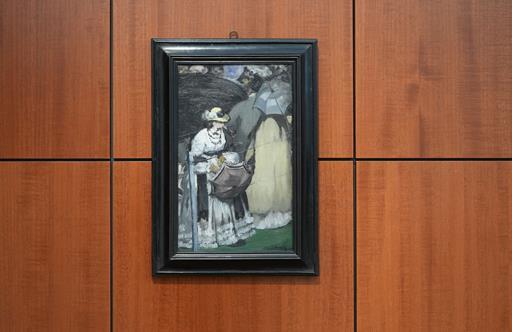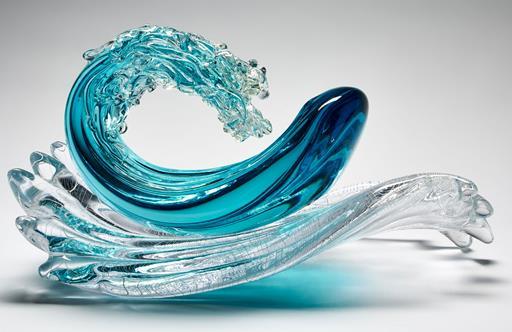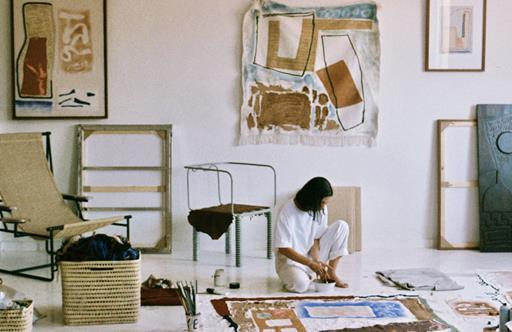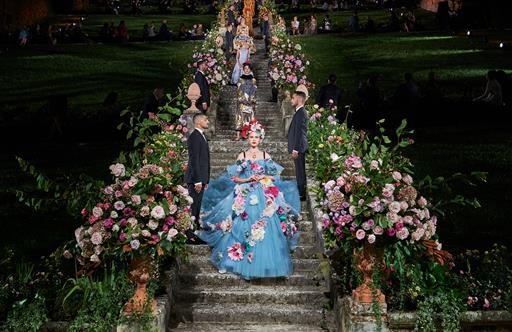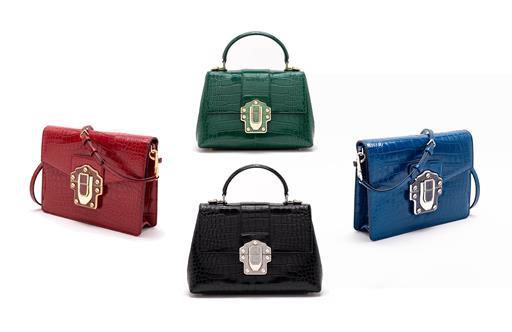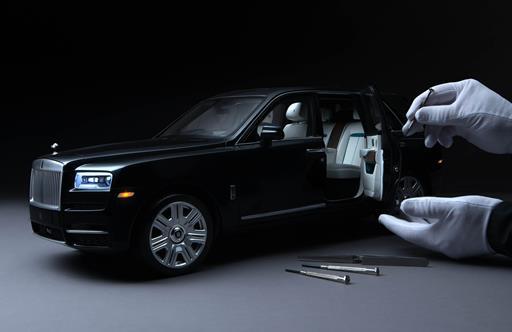The Human Factor
Art and craft merge at London studio Based Upon, whose works of astonishing scale also involve deeply personal insights and cutting-edge materials research.
What happens if, or when, AI does the thinking for us? When it bests us at what we’ve exalted for aeons: namely, our intellect? What will be valued, and who will it fall upon to showcase our creative worth? For Ian Abell, co-founder of London creative studio Based Upon, the answer may take us back to the dawn of human ingenuity: craft.
“What’s our edge?” he asks, discussing society’s existential crisis du jour: the great leap forward in artificial intelligence. “In the short term, at least, it’s our ability to make rather than our ability to think. A really beautiful handmade object has a power – we can have an almost visceral relationship to it … the sanctity of the materials, the time it’s taken to craft the thing, that sense of lineage.”
The making of We Are Here, which belies a cleverly integrated lighting system designed to complement the natural skylight in the LA home for which it was commissioned
That’s not to say that Abell is anti-intellectual or a Luddite – far from it. Since establishing Based Upon back in 2004 with his twin brother Richard, classically trained artist Alex Welch, and little more than a chunk of start-up capital and a bold idea, Abell has honoured thought, process and technological solutions to creative ideas – be they for a DJ booth or a baby grand piano. Hence, today, Based Upon occupies a liminal space between science and alchemy, design and art, with an amorphous USP and a starry client list that runs from Tiffany & Co, Rolls-Royce and Taj Hotels to the Qatari city of Lusail and aesthetes such as music-industry veteran James Perkins, whose Based Upon artwork, First Light, was included in a major auction at Dreweatts this May.
In their vast, 1,860sq m headquarters in the old industrial area around the back of Greenwich, the Based Upon team operates as a category-defying band of 35 designers, artists, engineers and metalworkers. Ian Abell and Welch take the creative lead, with the odd contribution from Richard Abell, who otherwise has the daunting task of overseeing the brand, its production and delivery, clients of huge net worth and his own team of perfectionists – the aim being for a consummate balance of creativity and professionalism.
Emulating the curves of the River Thames, the rarefied works in Based Upon’s Ribbon series – including this dining table – were created with Corian, steel, timber and Liquid Metal
Walking through the studio offers an eye-opening insight into Based Upon’s sleek operations. In the main production area, there’s a controlled industrial hum, with great, absolutely flat tables awaiting resin pours, and huge wall panels being shifted between work stations. In an immaculate, cordoned-off metal workshop, strips of brass developed for Steinway gleam luxuriously below vintage tool drawers and hanging hacksaws – a neat allegory for the brand’s extraordinary fusion of earthy craft and high luxury. Elsewhere, there are sculptural works of devastating beauty and technical accomplishment: a sumptuous representation of India in rumpled bronze on the wall; a metallic ribbon-like bar with fluid lines echoing the River Thames just outside; a piano trimmed in folded filigrees of brass and Liquid Metal – a material whose use and application across art and technology continues to be pioneered by the brand.
Another such material is Tramazite, a seemingly out-of-this-world substance made with resin and oxidised metals, developed by Based Upon, which appears both cosmic and deeply earthy, as if you’re gazing through the James Webb Space Telescope one minute and with a sky-high view of coral atolls the next. Also in Tramazite is Twist/D – a breathtaking piano in hypnotic blue, with sweeping lines and sculptural proportions inspired by geometry’s Golden Spiral and a sound created by Based Upon’s computer-modelling of 12 Steinway and Bechstein pianos from different eras, and incorporating soundscapes recorded, and filmed, on the Isle of Skye.
Birth of Tramazite, a sculpture made of Tramazite, aluminum honeycomb and bronze
Such pieces highlight the art and technical wizardry of Based Upon, but also the superpower that has driven its success: an ability to craft aesthetically beautiful pieces that resonate profoundly with clients, and a return, of sorts, to the patronage model of art, in which the client’s preferences are a key piece of the creative process.
“People find it unusual how much we actually care, and how deep you can go,” says Ian, who studied philosophy, politics and economics at Oxford. “We want to really bury into the essence of something, so that we’re not just producing form and materiality. If someone’s going to commission something, our opening gambit is, ‘Let’s start with something that’s meaningful to you, and then let’s allow it to grow from that.’ And really, what I found is that it comes down to quite a simple question: what is precious to you?”
The hand-sculpted Tondo Black – made with brass, aluminium and Jesmonite – evokes a spine-like tear in a lunar landscape
The response to that is often time, family, place or even power – but so far, says Ian, nobody has ever said another object. For private clients especially, commissioning Based Upon is about investing in something that resonates with their actual lives, that they can keep and pass down – moving into the realm of priceless significance rather than acquisitional art.
“When you move out of that idea of wanting to impress people or to have made a good investment in a piece of art, that’s the thing of beauty,” says Ian. “You’re honouring something that’s important, and it’s beautifully made, it’s well composed, and it feels made by hand, by people who really care. It gets into this notion of true value that we talk about, where value becomes entirely subjective, rather than something measurable by a market force.”
Ian Abell (left) and Alex Welch, who, along with Richard Abell, founded Based Upon, atop the three-metre-wide The Lost Fragment, crafted from a 50-million-year-old lump of granite
Multilayered narratives run through every privately commissioned piece: apparent in the workshop, where in one half-finished panel of Liquid Metal, layer upon layer of images relating to deep-seated personal memories slowly come into focus: a Mickey Mouse here, a picture of family that gives the impression of a sepia-tinged photo there.
As with the brand’s self-determined works, the story of a commissioned piece often begins with the team journeying into a landscape, where they may be drawn to a particular crack or mark within a rock. Such was the case for the work undertaken to create a giant set of doors for a couple’s Scottish castle, which ended up bearing the impressions of stones and leaves gathered by the team from the surrounding countryside.
Based on the geometry of a Möbius Loop, the bronze, Ian Abell-designed In the Cathedral of Your Spirit I Am Happy Queuing for Wine is the basis for a series of pieces, including a new wearable pendant, customised with bepoke phrases
Despite the glossiness of their oeuvre, the dichotomies of nature and our relationship to it remain fundamental to Based Upon’s work. As one example, The Lost Fragment (A Prosthetic Fallacy) – a piece of granite “repaired” for a sculpture tipped in bronze – plays on the idea of ascribing feelings to the planet as we continue to damage it. “It’s suggesting that we can’t really repair a million years of granite,” elaborates Ian. “It’s a prosthetic fix, however beautiful it is.”
The fact that this work resembles a Neolithic stone tool is also apt for Ian’s take on craft being just as worthy, vital and creative a pursuit as art, and his desire that, no matter how high-tech the production process, every Based Upon piece should always show the hand of the maker. Or, as he puts it: “Something that’s come through the hand is not lesser than something that’s come through the mind.”
Casts made from the surface of an unassuming mud hut in Uganda informed the silhouette of the bronze Fragmented Crack
All photos © Based Upon






